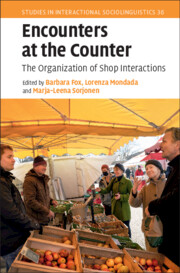Book contents
- Encounters at the Counter
- Studies in Interactional Sociolinguistics
- Encounters at the Counter
- Copyright page
- Contents
- Contributors
- 1 Encounters at the Counter
- 2 Approaching the Counter at the Supermarket
- 3 Customers’ Inquiries about Products
- 4 Offering a Taste in Gourmet Food Shops
- 5 Embodied Trajectories of Actions in Shop Encounters
- 6 Unpacking Packing
- 7 The Request-Return Sequence
- 8 Moving Money
- Appendix Transcription Conventions
- Index
- References
7 - The Request-Return Sequence
What Can Happen at the Interface between Picking up a Repaired Item and Paying for It
Published online by Cambridge University Press: 19 January 2023
- Encounters at the Counter
- Studies in Interactional Sociolinguistics
- Encounters at the Counter
- Copyright page
- Contents
- Contributors
- 1 Encounters at the Counter
- 2 Approaching the Counter at the Supermarket
- 3 Customers’ Inquiries about Products
- 4 Offering a Taste in Gourmet Food Shops
- 5 Embodied Trajectories of Actions in Shop Encounters
- 6 Unpacking Packing
- 7 The Request-Return Sequence
- 8 Moving Money
- Appendix Transcription Conventions
- Index
- References
Summary
This study focuses on sequences in which shoes and other leather items are returned to customers at a shoe repair shop in North America after having been repaired in some way. Before customers’ final payment for the items, the staff engage in three different ways of presenting the returned items, each making relevant a different kind of response from the customer. First, most frequent type, the staff person places the item on the counter and then turns to ring up the sale; in the second, the staff person engages in manual displays of the repair work that has been done; and in the third, the staff person verbally pursues a response through questions. The first type of presentation does not make conditionally relevant any kind of inspection or assessment from the customer, although customers may still inspect and assess; in the second, the pursuit is a bit stronger; and in the third, through questions from the staff such as ‘good?’, an assessment is made conditionally relevant. The study queries the theoretical implications for the general lack of pursuit of assessment at the shoe shop, compared with, for example, hair salons, in which assessments are typically actively pursued by the stylist.
Keywords
Information
- Type
- Chapter
- Information
- Encounters at the CounterThe Organization of Shop Interactions, pp. 214 - 254Publisher: Cambridge University PressPrint publication year: 2023
